BIRDS AS ART BULLETIN #224
Visit: www.birdsasart.com
CANON EOS-1D MARK III REPORT Important note: Because the Mark III images that accompanied this Bulletin were not created with a final production camera, Canon asked that they not be posted here at this time.
TODD GUSTAFSON CO-LEADING DE SOTO IPT #2
ASSORTED BIRDS AS ART KUDOS
DARRELL GULIN WEB SITE
COMING SOON: PRESIDENT’S DAY IPT REPORT & EVERGLADES NP IN-THE-FIELD REPORTS
ROBERT O’TOOLE PRIVATE & SMALL GROUP WORKSHOPS (ROT-Ws)
INTERVIEW
NYC SEMINAR
IPT UPDATES
Contact us by phone at 863-692-0906 (Eastern Time Zone) or by e-mail at birdsasart@att.net or birdsasart@verizon.net. The att e-mail address is best from overseas.
We gladly accept credit card orders by phone 8am till
You can use the Paypal links on the web site to order anything. Just type in the item(s) and the amount. If using your own Paypal account, please send to either of the e-mail addresses above.
Photographic theme: A few
EOS-1D Mark III
images and some of my
American Alligator chomping on Brown Pelican, Anhinga Trail, Everglades National Park
Image copyright 2007: Arthur Morris/BIRDS AS ART
Canon 100-400mm IS L Zoom lens handheld at 210mm with the EOS-1D Mark III. ISO 3200.
Evaluative Metering -2/3 stop: 1/500 sec. at f/5.
On the Friday Anhinga Trail ITF-Workshop we were fortunate to watch an alligator dine on an unfortunate Brown Pelican. With the Mark III in my hand I figured that it would be a good chance to check out the high ISO settings; with the gator chewing I knew that I needed a shutter speed of at least 1/500 sec. to freeze the action so ISO 3200 it was. I think that I had set the Custom Function for High ISO Noise Reduction and the image was processed in DPP with Low Noise Reduction set for both color and luminance. The converted RAW image exhibited very little noise. Both Robert O’Toole and I agreed that the noise in this and other ISO 3200 images from the Mark III was comparable to ISO 400 in the 1Ds MII and the MII 1DN. Virtually noise-free images at ISO 3200 will open up new worlds to nature photographers. As I said, get your name on the list now…
American Alligator swallowing Brown Pelican, Anhinga Trail, Everglades National Park
Image copyright 2007: Arthur Morris/BIRDS AS ART
Canon 100-400mm IS L Zoom lens handheld at 190 mm with EOS-1D Mark III. ISO 6400.
Evaluative Metering -2/3 stop: 1/1000 sec. at f/5.
As it got darker and the gator’s thrashing became more violent so I went for the whole nine yards: ISO 6400. The large J-PEG (representative of the RAW file when viewed in Breezebrowser) exhibited lots of noise—especially in the red channel, so I converted the image in DPP with High Noise Reduction set for both color and luminance. The resulting TIFF file looked much better but I wanted to eliminate all of the color noise in the blacks so using the techniques detailed in this section of our Digital Basics File: Using Color Range Selections to Remove a Color Cast and was thrilled with the results. (You can learn more about Digital Basics here: http://www.birdsasart.com/digitalbasics.htm (Photoshop note: a bit of canvas was added to the top of this image.)
CANON EOS-1D MARK III REPORT
From Thursday, February 22 through Wednesday morning, February 28 I had the opportunity to work with the just- (and I mean just) announced Canon EOS 1D Mark III Professional Digital Camera Body. Best advice: call Gary Farber at Hunt’s Photo and get on the list now; this will surely be the hardest-to-get-camera in the history of 35 SLR photography. After one day in the field with this amazing camera I placed an order for two Mark IIIs through the Explorers of Light Program. What’s the big deal? 10 frames per second. 10.1 megapixels (with apologies to the folks who were positive that a 22mp Canon body was just over the horizon. What Canon did was replace the EOS 1D MIIN rather than—as everyone had expected—replace the EOS 1Ds MII). Images are processed at 14 bits for a total color depth of up to 16,384 tones per pixel, compared to 4,096 tones per pixel from 12 bit images. (This will result in smoother color gradations throughout the image file and should eliminate the circular banding effect when the sun is included in the frame.) 1.3X crop factor. The control of noise at the higher ISO settings is mind-boggling (See the two remarkable gator images above). The ISO settings range from 50-6400 (again, see the two images above). The Mark III, with the new high-capacity, lightweight, compact lithium-ion battery (thank you Nikon), much lighter than its predecessors. With a totally new AF system that features 19 cross-type sensors, autofocus is fast and responsive; you can almost feel the recoil as the image snaps in to focus. AI Servo AF is more accurate than with any camera body I have every used. The Dual Digic III processors allow for creating bursts of up to 30 RAW images; I never came close to filling the buffer.
The Mark III features something called the “EOS Integrated Cleaning System.” The bottom line on that: I processed more than 40 images created over a span of 6 days with the DPP software and did not encounter a single speck of sensor dust. Amazing. You can fine tune AF accuracy for each lens that you own. Amazing again! The tiny joy stick can be used to scroll through a magnified image and to toggle back and forth between the central sensor and AFPS. You can (I did) choose to apply Noise Reduction in high ISO images. Most of the previous Personal Functions (which were a pain to add and work with) are now included with the Custom Functions (which have been divided into four categories to make things a bit simpler). And several valuable new Custom Functions have been added. Though I barely had time to learn and set up the custom functions, by the time I had to send the cameras (I had two) back, I had personalized the Mark IIIs so that each could do things quickly that I never thought possible.
The Mark III features Live View; you press the set button in the center of the thumb wheel and you see the live view (as framed in your lens) on the bright 3 inch LCD screen on the back of the camera. At first it seemed that this feature is pretty much a dud for photographing birds or wildlife in action, but because of some mis-communication and a missed e-mail, I did not realize that you can view a live histogram on the LCD when you are in Live View. Thus, if you have a relatively static situation you can view the histogram before making an image and add or subtract light as needed to ensure that you are exposing to the right and creating the highest possible quality image file. I can’t wait to get my very own Mark IIIs to give this feature a test drive. Jeez, I almost forgot to mention that Highlight Tone Priority can be set to increase the dynamic range when working with bright whites in bright sun.
Above are the basics that guarantee that this is the finest wildlife and sports camera ever. You can learn more about the seemingly zillion other features, improvements, and accessories here:
http://www.robgalbraith.com/bins/content_page.asp?cid=7-8736-8850
and read Canon’s 63 page White Paper here:
http://www.robgalbraith.com/public_files/Canon_EOS-1D_Mark_III_White_Paper.pdf
There is some amazing stuff on the camera here:
http://web1.canon.jp/camera-museum/tech/l_plant/index.html
And, on an
unrelated note, visiting the
http://www.canon.com/camera-museum/tech/l_plant/f_index.html
Camera operation, controls, and custom functions on this amazing new professional camera body are quite different in most instances from the previous generations of Canon Professional Digital Cameras (all of which were either quite similar or identical to their predecessors). The learning curve will be a bit steep for most folks. My one major criticism of the Mark III is that when you are working outdoors (even on cloudy-dark days) it is virtually impossible to see the edge of the histogram box; this makes it difficult to accurately expose to the right. I let Canon know about this problem after evaluating each of the previous pro digital bodies but alas, they still have not gotten it right. I am hoping that this can be fixed with a firmware update; if not, my Mark III will sport a one-inch strip of yellow masking tape along the right edge of the histogram box. That said, I am chomping at the bit to get my hands on my Mark IIIs.
Anhinga, post-breeding male, Anhinga Trail, Everglades National Park
Image copyright 2007: Arthur Morris/BIRDS AS ART
Canon 500mm f/4 L IS lens with 2X II TC and the EOS-1D Mark III. ISO 1250.
Evaluative Metering at zero set manually: 1/125 sec. at f/8.
I was thrilled with the color and the clean look of the Mark III files, and I was quite pleased with the DPP conversions as well. The much improved and all-new AF system is superb.
TODD GUSTAFSON CO-LEADING DE SOTO IPT #2
BBC Wildlife Photographer of the Year 2006 Bird Behavior honoree and my pal Todd Gustafson—who was originally scheduled to co-lead the first Fort DeSoto IPT but had to cancel--will be co-leading the Fort DeSoto #2 IPT (along with new Florida resident Robert O’Toole--also a BBC Wildlife Photographer of the Year 2006 honoree), Alfredo Don Diego Forns, and of course and as always, yours truly. You can see some of Alfred’s and Fab’s great images in their Live Books-Powered Portfolios here: www.avianscapes.com
With what is shaping up to be a small group this IPT should prove to be exceptional. Here are the details:
NEW! Fort DeSoto IPT: APR 17-19, 2007. Slide program on the evening of Monday, APR 16. 3-DAY: $999 (Limit 14; openings: 10). Courtship and breeding behaviors of Laughing Gull and Royal and Sandwich Terns. Herons, egrets (including both dark and light phase Reddish Egret), shorebirds (including Long-billed Curlew), gulls, terns, and skimmers among others.
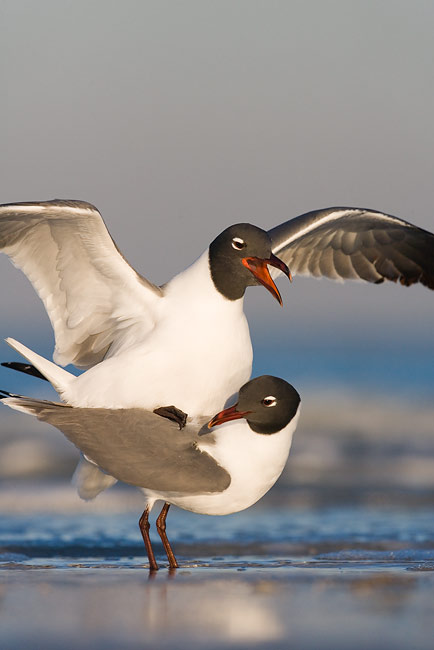
Laughing Gulls copulating, Fort DeSoto Park, St. Petersburg, FL
Image copyright 2006: Arthur Morris/BIRDS AS ART
Canon 500mm f/4L IS lens with EOS 1Ds Mark II. ISO 320.
Evaluative Metering at zero: 1/1600 sec. at f/8.
As fate would have it, conditions were perfect the morning after the DeSoto IPT group left. I use my Panning Ground Pod whenever possible when working at the beach. You simply cannot create such intimate images when standing or even when kneeling behind your tripod. Be sure to wear something long-sleeved to protect the skin on your elbows. And be sure to keep your hands clean! Pulling the sleeves of your upper garment down over your hand or hands when getting up can keep the sand off of your hands... (To learn more about the Panning Ground Pod, click here: http://www.birdsasart.com/accs.html#The%20Walt%20Anderson%20Panning%20Ground%20Pod)
ASSORTED BIRDS AS ART KUDOS
From Kent Wilson via e-mail:
Just a
note to say that your Site Guides were invaluable on our trip to
From Tom and Therisa Stack via e-mail:
What a wonderful pleasure it was to attend your one day Anhinga Trail Workshop. We learned more in one day than we could have imagined thanks to your incredible passion for bird photography combined with an amazing ability to teach. In addition to being a talented photographer you are truly a remarkable man. Thank you for an unforgettable experience!
From Betty Wisse via e-mail:
I want to express my gratitude for all of the knowledge you shared with us on
the
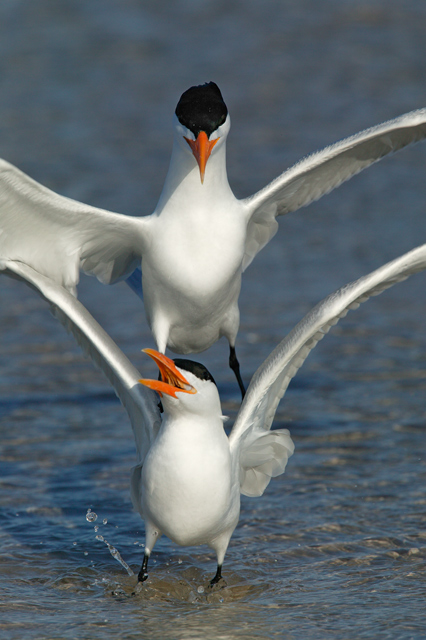
Royal Terns,
pre-copulatory stand,
Image copyright 2006: Arthur Morris/BIRDS AS ART
Canon 500mm f/4L IS lens with 2X II TC and EOS 1Ds. ISO 250.
Evaluative Metering -1/3 stop: 1/1000 sec. at f/11.
Male Royal Terns practice their balance by standing atop their mates before copulating. With the old 1Ds I got so excited here that I filled the buffer in a few seconds and missed the copulation. The Mark III’s 30-frame RAW buffer will be most welcome.
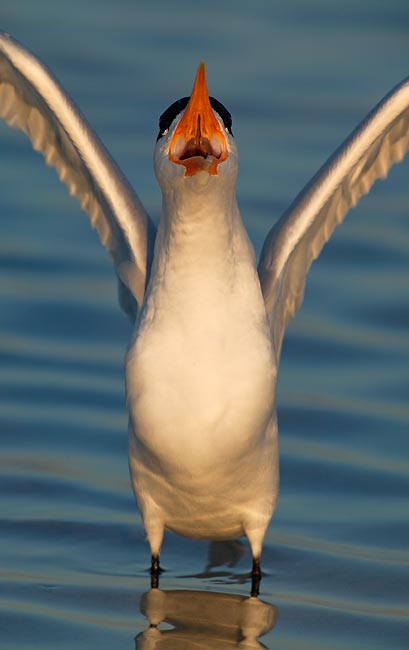
Royal Tern with wings raised, Fort DeSoto Park, St. Petersburg, FL
Image copyright 2006: Arthur Morris/BIRDS AS ART
Canon 500mm f/4L IS lens with 2X II TC and EOS 1Ds. ISO 250.
Evaluative Metering at zero: 1/320 sec. at f/11 set manually.
This is the little known and rarely photographed post-copulatory display. Note that with the softer light than in the previous image that no underexposure was needed to save the whites. You can learn all you need to know about exposure and histogram in ABPII. Learn more here: http://www.birdsasart.com/ABPII.htm
DARRELL GULIN WEB SITE
Darrell Gulin has been a great friend for years. He is a popular photo-tour leader who travels the world each year and is a stunningly successful stock photographer. He helped me shape my career early on and has helped many other professionals do the same all in the name of sharing, generosity, and friendship. He is one of Canon’s newest Explorers of Light. You can learn more about Darrell and see some of his great images here:
Ring-billed Gull, immature
kiting, West
Image copyright 2007: Arthur Morris/BIRDS AS ART
Canon 300mm f/4 L IS lens handheld with the EOS-1D Mark III. ISO 400.
Evaluative Metering + 2 stops off the white sky set manually: 1/1000 sec. at f/4.5.
Combining the Mark III with
the 300 f/4 IS L lens makes for a great flight photography rig with both IS
and lightning quick. This image was made one Jim Neiger’s Pontoon boat. See
also the Snail Kite image below. You can learn more about Jim’s
http://www.birdsasart.com/bn215.htm
COMING SOON: PRESIDENT’S DAY IPT REPORT & EVERGLADES NP IN-THE-FIELD REPORTS
The next
Bulletin will include reports and images from both the President’s Holiday SW
Florida IPT and the three One-day In-The-Field Workshops at Anhinga Trail,
http://www.birdsasart.com/siteguides.htm#SW%20FLORIDA%20SITE%20GUIDE%20AVAILABLE
Snail Kite, perched male,
West
Image copyright 2007: Arthur Morris/BIRDS AS ART
Canon 300mm f/4 L IS lens handheld with the EOS-1D Mark III. ISO 400.
Evaluative Metering + 1/3 stop off the green bulrushes set manually: 1/1000 sec. at f/7.1.
If you want Snail Kites,
book a morning with Jim on
http://www.birdsasart.com/bn215.htm
ROBERT O’TOOLE PRIVATE & SMALL GROUP WORKSHOPS (ROT-Ws)
Robert O’Toole has been
helping me with my IPTs for several years now. As noted above, he had his
first BBC honored image in 2006; I expect him to have many more images
honored. Robert is about as creative as any photographer I know, and not a
day goes by when I do not learn from him. And he is an absolute Photoshop
magician. Robert recently moved from LA to
The workshops will be held
at some of the best areas in southwestern
Personalized instruction is
the best way to ensure that you will learn what you need to know and do so at
your own pace. Both the photography and the post-processing workshops are
limited to four participants. A non-refundable deposit of $199 is required for
all workshops. The balance is due 30 days before the workshop date. Credit
cards are not accepted at this time.
Rates:
Single person one day: $400 per day or $250 for half day.
A full day includes 2 in-the-field sessions and Post processing instruction during and after lunch.
Two participants: $350 per person per day or $200 per person for half day
Three participants: $300 per person per day or $175 per person for half day
Four Participants: $250 per person per day or $150 per person for half day
Please contact Robert O’Toole via email at
Robert@robertotoole.com or via mobile phone at 310-619-8017.
For additional details please see
www.robertotoolephotography.com (Note: Be sure to check out Robert’s
great images when you visit.)
Please make deposit checks
out to “Robert O’Toole” and mail them to: Robert O’Toole,
Brown Pelican draining water from bill pouch, Little Estero Lagoon, Ft. Myers Beach, FL
Image copyright 2007:
Canon 70-200mm f/2.8 L IS lens with 1.4X II TC handheld at 215mm with the EOS-1D Mark III. ISO 400.
Evaluative Metering + 1 2/3 stops: 1/640 sec. at f/4.
This image was created on a very foggy afternoon, thus the +1 2/3 stops of overexposure. Even in dim conditions the Mark IIIs AF system performed admirably.
INTERVIEW
Fabiola Del Alcazar, Alfred Forns’ life partner (who helps out often on my IPTs) asked if I would answer a few questions for her blog. Some of them were quite intriguing and atypical of the stuff that I am often asked. Here is the text of that interview:
“Arthur Morris/The Man Behind the Legend”
F: What do you recall as the most memorable moments of your career?
AM: The standing ovation that I received from 700 folks when I key-noted at
the 2005 North American Nature Photographers Association Summit in
F: Is there a photographer or artist that had vital influence on your vision?
AM: The three that stand out the most are Tim Fitzharris, John Shaw, and Rod Planck.
F: What would you recognize as the dominant elements of your style?
AM: Pleasing compositions, clean backgrounds, exceptional sharpness, and a love and understanding of light and its many qualities.
F: Where do you draw the line, what would you NOT do for a picture?
AM: That is an exceedingly difficult question that I will attempt to answer honestly. I do my very best not to disturb my subjects, and certainly make every effort not to influence their lives in a negative way, but at times the subject or subjects that I am approaching do fly away, and on rare occasions, it is possible that I might have a somewhat negative influence on their lives. That said, those are some very fine lines to draw. Early on, I broke a branch that was blocking my view of a Saw Whet Owl. The loud snap sent the bird flying off. I would surely not do anything like that again.
What bugs me the most is that there are lots of folks out there who state that anyone who causes a bird to fly off at their approach or who steps on a blade of grass is a criminal. Invariably, I have learned that the folks who freely set high ethical standards for others do absolutely horrific stuff when there is nobody around...
F: Arthur Morris, what separates the man from the legend?
AM: My generosity and my work ethic. Among some folks who do not know me I have a reputation as some sort of ogre, but I am a really just a big teddy bear. I am opinionated and a bit loud at times, but always a sweetie.
F: After a successful and rewarding career, is there something still missing?
AM: I am truly blessed, but would love to have a beautiful loving woman in my life again. (Interested applicants are invited to e-mail.) <smile>)
F: Any regrets?
AM: Yeah. One big one: that I did not switch to digital sooner!
F: As a Canon contract photographer, you got to test the new Mark III. What were your first impressions?
AM: It is a truly amazing camera; fast and light. It will require a steep learning curve as there are tons of Custom Functions to master and the layout of the controls and the ergonomics are quite different from the previous EOS professional digital camera bodies. Noise control at the higher ISOs is simply amazing.
F: What would be your advice for an amateur photographer making the transition to pro?
AM: Photograph what you love, learn to write, and work as hard as I have. <smile>
Sandhill Crane on nest,
Indian
Image copyright 2007: Arthur Morris/BIRDS AS ART
Canon 500mm f/4 L IS lens with the EOS-1D Mark III. ISO 3200.
Evaluative Metering +2 stops: 1/100 sec. at f/4.
It is hard to believe that this is an ISO 3200 image. I was surprised here that I needed to add two stops of light in order to get some date in the histogram’s fifth box.
NYC SEMINAR
With 57 folks already registered for this event, there is a possibility that the seminar will sell out well in advance. We can comfortably entertain and educate 125 folks…
The Art of Nature Photography; It Ain’t Just Birds!
Weekend How-To Seminar
The cost of the weekend seminar is $169. The cost of either single day is $99. Members of qualifying camera clubs are invited to apply a $10 discount. (If you are a member of a camera club or other photography organization please e-mail for details.) Register with a friend or spouse and take $10 off each registration. Register in groups of four or more and take $20 off of each registration. Get a group of ten photographers together and apply a $30 discount to each registration. (Please e-mail for group registration details.) It is highly recommend that folks purchase the buffet luncheon option ($15/day includes tip and tax) as there are no fast food restaurants nearby. Those purchasing the lunch option will receive their lunch coupon when they check in each morning.) The cost of the weekend seminar plus the two lunches is $199.
To
register, send a check for the full amount made out
to "Arthur Morris" to PO Box 7245, Indian Lake Estates, FL 33855, call with a
credit card: 863-692-0906, or send a Paypal (using either any link on our site
or your Paypal account) to us at
birdsasart@att.net In all cases, we will need your e-mail address, your
mailing address, and your daytime and evening phone numbers.
Here is our Cancellation Policy: If for any reason you need to withdraw,
please notify us ASAP. Once we receive your e-mail, phone call, or written
notice of your cancellation the following fees apply: cancel before
The doors will
open on both days at
The
seminar hotel is the Crowne Plaza JFK Hotel,
151 -20
Baisley Blvd.,
,
NY 11434.
The first 40 attendees who register to stay at least two nights at the
seminar hotel will receive a free Lens Pen Combo Kit—a
$20 value--plus our detailed instructions (those sent via e-mail). Room
rates anywhere in NYC are extremely high; we have negotiated a fantastic low
rate of $139 per night for those who register in a timely fashion. (The
lowest internet rate that I could come up with for the
Crowne
Plaza was $161/night). To secure
your room, please call 718-489-1000 with a credit card in hand, state that you
wish to make a BIRDS AS ART reservation, and give them the confirmation code:
BAA.
Please click here for additional details and schedule:
http://www.birdsasart.com/seminars.htm.
In August, fall shorebird migration is well underway at the nearby Jamaica Bay Wildlife Refuge. Photography at the East Pond there can be excellent, especially for those who do not mind crawling in the mud and muck. Folks joining us from out of town should strongly consider bringing their gear and doing some photography at J-BAY, one of my favorite places on the planet, and one of my three soul-places. I would advise staying on after the seminar (rather than coming in early) as the juvenile shorebirds, which can be extraordinarily tame, begin arriving in mid-August.
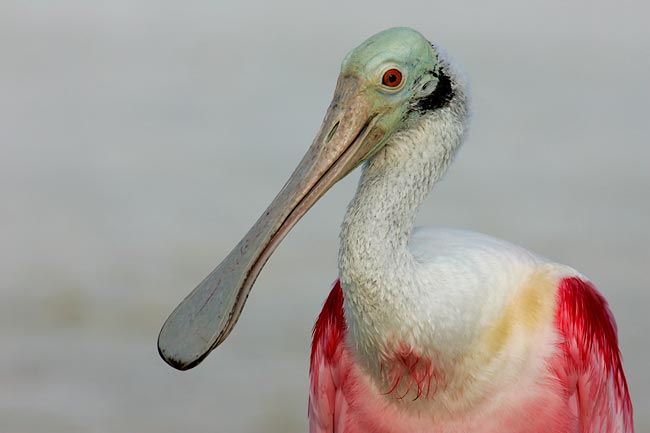
Roseate Spoonbill, breeding plumage, Fort DeSoto Park, St. Petersburg, FL
Image copyright 2006: Arthur Morris/BIRDS AS ART
Canon 600mm f/4L IS lens with 2X II TC and EOS-1D Mark II. ISO 250.
Evaluative Metering +1/3 stop: 1/250 sec. at f/16.
Spoonbills can be found at DeSoto on any day of the year. I arrived in the pre-dawn and was able to get close to several spoonbills by sitting and wriggling my way forward; most folks arrive at their shooting locations way too late.
IPT UPDATES
Fort DeSoto IPT: APR 13-15, 2007. Slide program on the evening of Thursday, APR 12. 3-DAY: $999 Limit 14: openings 2.) Co-leaders: Robert O’Toole, Alfred Forns, and Robert Amoruso. Courtship and breeding behaviors of Laughing Gull and Royal and Sandwich Terns. Herons, egrets (including both dark and light phase Reddish Egret), shorebirds (including Long-billed Curlew), gulls, terns, and skimmers among others.
NEW! Fort DeSoto IPT: APR 17-19, 2007. Slide program on the evening of Monday, APR 16. 3-DAY: $999 (Limit 14; openings: 10). Co-leaders: Todd Gustafson & Robert O’Toole. Courtship and breeding behaviors of Laughing Gull and Royal and Sandwich Terns. Herons, egrets (including both dark and light phase Reddish Egret), shorebirds (including Long-billed Curlew), gulls, terns, and skimmers among others.
NEW!
Silver
Salmon Creek:
Bosque #1: "The Fall Color IPT"
Bosque #2: "The Pre-Thanksgiving IPT"
Bosque #3: "The Post-Thanksgiving IPT"
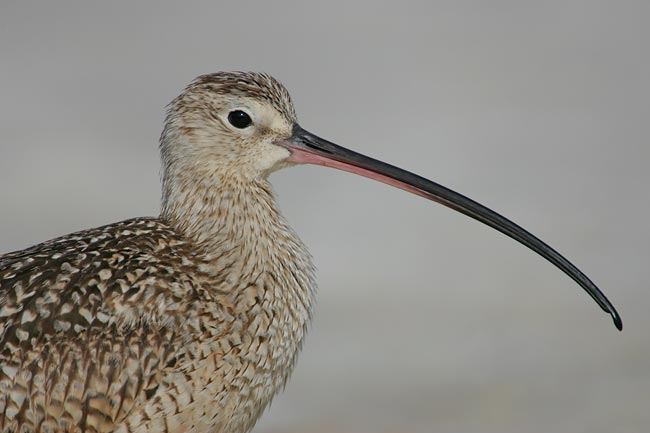
Long-billed Curlew,
Image copyright 2006: Arthur Morris/BIRDS AS ART
Canon 500mm f/4L IS lens with 2X II TC and EOS-1D Mark II. ISO 250.
Evaluative Metering +1/3 stop: 1/1600 sec. at f/8.
Here I used the widest possible aperture (f/8 with the 2X TC) and created an extremely sharp image despite the fact that I could have stopped down. Why? To ensure a totally smooth out-of-focus background.
Best and love and great picture-making to all,
artie
Note: Arthur Morris has been a Canon contract photographer since 1994 and continues in that role today. Hunt's Photo of Boston, MA is a BAA sponsor as it Delkin Devices. Back issues of all BAA Bulletins can be found in the Bulletin Archives which may be accessed from the home page at www.birdsasart.com